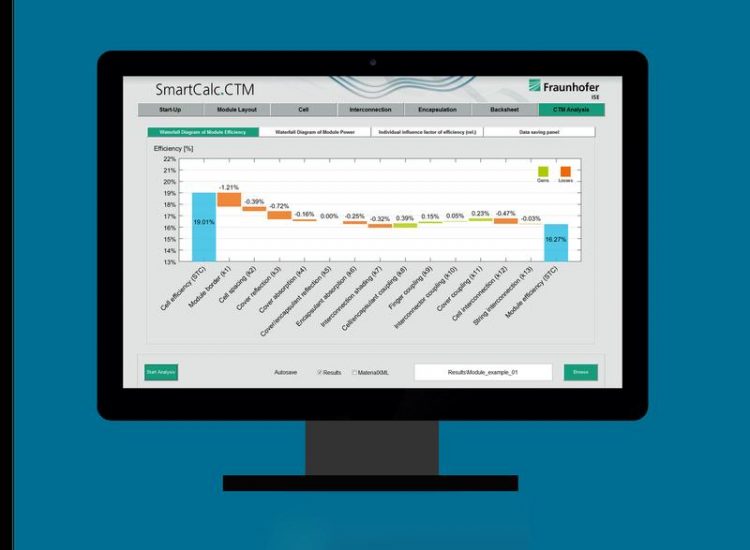Fraunhofer ISE Develops SmartCalc.CTM

With SmartCalc.CTM, Fraunhofer ISE has developed a software that helps reduce the cell-to-module power losses in PV module manufacturing. ©Fraunhofer ISE
SmartCalc.CTM determines the cell-to-module effects, or “CTM”, which occur when solar cells are integrated into a module. Starting with the cell power, the software calculates the optical losses and gains (e. g. reflection), electrical losses (e. g. due to resistances) and the geometrical losses (inactive areas) in solar modules.
The software tool assists in analyzing potential yields, thus enabling PV manufacturers to determine how new materials or concepts would affect module efficiency. In the model, the interaction between components and process steps are optimized in such a way that the best possible module – with the highest power or the maximum efficiency under the given boundary conditions – is achieved.
“SmartCalc.CTM was conceived for module manufacturers and material suppliers,” explains Matthieu Ebert, team leader of “Module Efficiency and New Concepts” at Fraunhofer ISE. “Our software offers added value in that it can quickly analyze the interplay between the influencing factors for a module design and present these in a clear manner.”
The underlying models in SmartCalc.CTM provide detailed yet flexible control at the same time. Properties of solar cells, encapsulation material or module glass can be easily adapted. Thus, the use of new materials and components and their effect on the module efficiency can be easily determined, enabling new technologies and module designs to be evaluated rapidly.
The software can also be used to optimize costs. For example, different less-expensive materials can be compared and evaluated with respect to the module’s performance efficiency.
SmartCalc.CTM is based on a simulation model which has been published and is under development at Fraunhofer ISE since 2008. The model considers the many factors that influence module performance such as optical and electrical effects as well as singular components, for example, solar cells, glazings or the module frame. As a result, potential improvements can be indentified easily and applied in practice.
The CTM factors can change drastically depending on the choice of solar cell, module materials and the module assembly. “With a well-selected combination of materials and module design, an optimization of all factors can even lead to a CTM > 100%, indicating a higher output as compared to the sum of all solar cells before integration,” says Ebert.
SmartCalc.CTM has a user-friendly interface with an accompanying operating manual. As well as the software license, the team at Fraunhofer ISE offers consulting and R&D support for analyzing and optimizing the simulation results. The software shall be continually developed in order to keep pace with future module assemblies.
https://www.cell-to-module.com/
https://www.ise.fraunhofer.de/en?set_language=en
Media Contact
All latest news from the category: Power and Electrical Engineering
This topic covers issues related to energy generation, conversion, transportation and consumption and how the industry is addressing the challenge of energy efficiency in general.
innovations-report provides in-depth and informative reports and articles on subjects ranging from wind energy, fuel cell technology, solar energy, geothermal energy, petroleum, gas, nuclear engineering, alternative energy and energy efficiency to fusion, hydrogen and superconductor technologies.
Newest articles

Sea slugs inspire highly stretchable biomedical sensor
USC Viterbi School of Engineering researcher Hangbo Zhao presents findings on highly stretchable and customizable microneedles for application in fields including neuroscience, tissue engineering, and wearable bioelectronics. The revolution in…

Twisting and binding matter waves with photons in a cavity
Precisely measuring the energy states of individual atoms has been a historical challenge for physicists due to atomic recoil. When an atom interacts with a photon, the atom “recoils” in…

Nanotubes, nanoparticles, and antibodies detect tiny amounts of fentanyl
New sensor is six orders of magnitude more sensitive than the next best thing. A research team at Pitt led by Alexander Star, a chemistry professor in the Kenneth P. Dietrich…





















